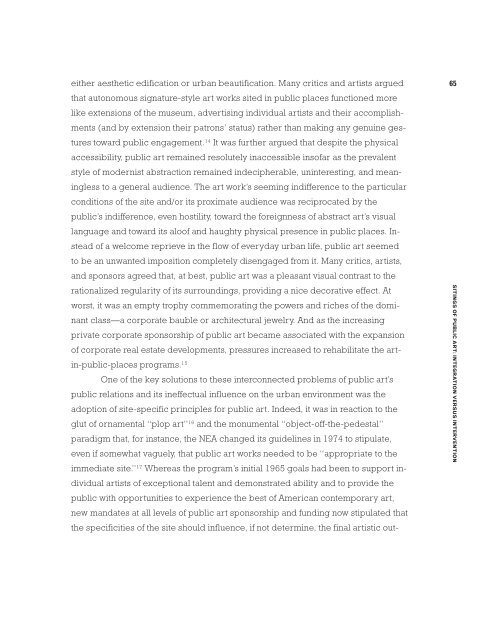ONE PLACE AFTER ANOTHER - Monoskop
ONE PLACE AFTER ANOTHER - Monoskop
ONE PLACE AFTER ANOTHER - Monoskop
You also want an ePaper? Increase the reach of your titles
YUMPU automatically turns print PDFs into web optimized ePapers that Google loves.
either aesthetic edification or urban beautification. Many critics and artists argued<br />
that autonomous signature-style art works sited in public places functioned more<br />
like extensions of the museum, advertising individual artists and their accomplishments<br />
(and by extension their patrons’ status) rather than making any genuine gestures<br />
toward public engagement. 14 It was further argued that despite the physical<br />
accessibility, public art remained resolutely inaccessible insofar as the prevalent<br />
style of modernist abstraction remained indecipherable, uninteresting, and meaningless<br />
to a general audience. The art work’s seeming indifference to the particular<br />
conditions of the site and/or its proximate audience was reciprocated by the<br />
public’s indifference, even hostility, toward the foreignness of abstract art’s visual<br />
language and toward its aloof and haughty physical presence in public places. Instead<br />
of a welcome reprieve in the flow of everyday urban life, public art seemed<br />
to be an unwanted imposition completely disengaged from it. Many critics, artists,<br />
and sponsors agreed that, at best, public art was a pleasant visual contrast to the<br />
rationalized regularity of its surroundings, providing a nice decorative effect. At<br />
worst, it was an empty trophy commemorating the powers and riches of the dominant<br />
class—a corporate bauble or architectural jewelry. And as the increasing<br />
private corporate sponsorship of public art became associated with the expansion<br />
of corporate real estate developments, pressures increased to rehabilitate the artin-public-places<br />
programs. 15<br />
One of the key solutions to these interconnected problems of public art’s<br />
public relations and its ineffectual influence on the urban environment was the<br />
adoption of site-specific principles for public art. Indeed, it was in reaction to the<br />
glut of ornamental “plop art” 16 and the monumental “object-off-the-pedestal”<br />
paradigm that, for instance, the NEA changed its guidelines in 1974 to stipulate,<br />
even if somewhat vaguely, that public art works needed to be “appropriate to the<br />
immediate site.” 17 Whereas the program’s initial 1965 goals had been to support individual<br />
artists of exceptional talent and demonstrated ability and to provide the<br />
public with opportunities to experience the best of American contemporary art,<br />
new mandates at all levels of public art sponsorship and funding now stipulated that<br />
the specificities of the site should influence, if not determine, the final artistic out-<br />
65<br />
SITINGS OF PUBLIC ART: INTEGRATION VERSUS INTERVENTION

















